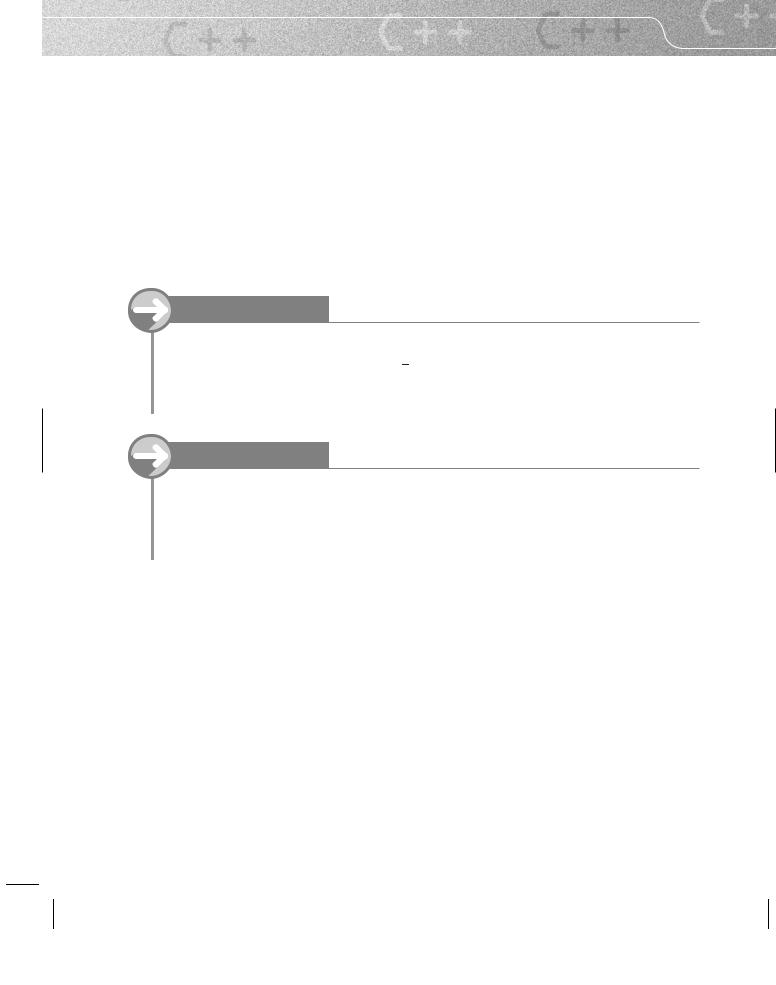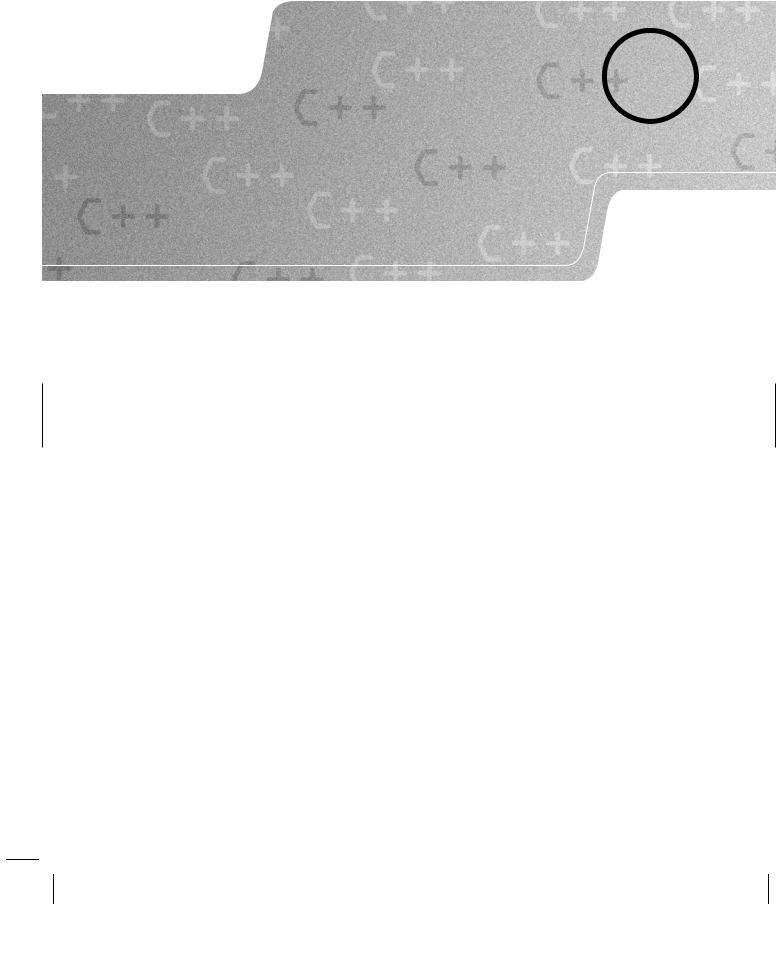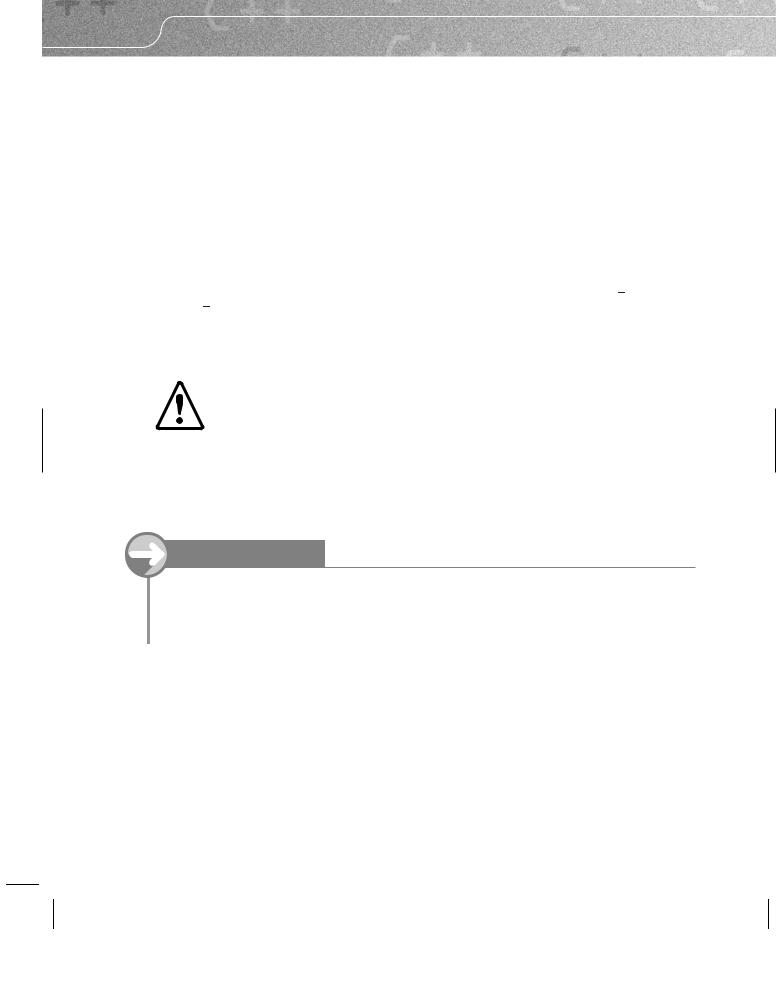
You Can Program In C++ (2006) [eng]
.pdf
78 |
CHAPTER 4 |
receiving object (the variable on the right) and using appropriate behavior for that type of object. By default, it ignores all leading whitespace characters (spaces, tabs, carriage returns, and newlines) in the source object (std::cin). It terminates input at the first unsuitable character. By default, C++ deems trailing whitespace to be unsuitable for all types. This means that when you use std::cin >> x, regardless of the type of x, all leading whitespace is ignored and input ceases not later than the first trailing whitespace character. Some data types, such as the numerical types, classify other characters (e.g. punctuation marks) as being unsuitable. Unlike getline( ), which extracts and discards the terminating character (by default the newline character), the extraction operator leaves the terminating character in the input, ready for the next use of the input object.
Here is a small code snippet using the extraction operator to insert input into a std::string object.
std::string word; std::cin >> word;
T R Y T H I S
Write a program that uses the above code to extract words from std::cin. Experiment with this program and the earlier ones until you are sure you understand the different behavior as regards the significance of spaces in your input.
Output with std::cout
There are two main C++ ways to output data to an output object such as std::cout. The first is by using the put( ) function to put a single char value to the output object. For example,
char c('x');
char newline('\n'); std::cout.put(c); std::cout.put(newline);
would display an ‘x’ in the console window and move to a new line for any subsequent output.
T R Y T H I S
Write a program to use the above code and verify that it works as predicted.
The streaming operator is the commoner mechanism for data output. In this case, we use the left-shift operator to represent streaming (or shifting) data into the output object. That is, we use << to insert data into an output stream. We have already made extensive use of this operator to display prompts and results.
Standard Console Output Objects
C++ provides two other standard output objects; std::cerr and std::clog. C++ uses std::cerr for reporting errors. Those coming from a C background will already be familiar with the concept because they have a similar idea implemented by C’s stderr object. The default destination for std::cerr is the monitor. You will eventually learn how to change the connection to a file or to some other sink for data. A

NAMESPACES AND THE C++ STANDARD LIBRARY |
79 |
second default feature of std::cerr is that it is unbuffered. That means that data sent to std::cerr is immediately processed and not batched up until it becomes necessary or desirable to deal with it.
The intended use of std::clog is for logging events to some suitable data sink. The assumption is that such events will be a normal part of the program’s execution and so there will be no hurry to complete the process of dispatching the data to the output object. For that reason, std::clog is normally buffered (as is std::cin), and completion of processing will be delayed until either it is forced or the buffer is full. Like std::cerr, std::clog defaults to the monitor.
Even though all three standard console output objects default to the monitor, it is good practice to use the appropriate one for the purpose at hand. If you want to report an error, use std::cerr, but if you are logging an event that does not constitute an error (it might be a failure of some process, but not one that the programmer wishes to treat as an error), use std::clog. Use std::cout for normal program output and interaction with the user. By always using the appropriate output, you will find it simple to modify programs to dispatch the different categories of output to different places when you have learned how to do that.
T R Y T H I S
Write a program that collects some words from the keyboard, stores them in a std::vector <std::string> object (by using push back( )), sorts them, and then displays the sorted list
on the monitor. The program should also log the start and end of each phase: data acquisition, data processing, and data output. Of course, you will also arrange to catch possible exceptions and send a message to an appropriate output object.
T R Y T H I S
The fgw::playpen type supports four different plotting modes. See the next section for details. Write a program that will help you explore these different plotting modes. To get best advantage you will need to be able to change the origin and the scale as well as the plotting mode. Do not use fully elaborated names. Use using declarations for the C++ Standard Library elements and a using directive for my library.
Playpen Plotting Modes
fgw::playpen supports four different plotting behaviors. The default one, fgw::direct, simply replaces the current pixel color with the one designated by the color argument provided by any function used for modifying the Playpen. For example, paper.plot(3, 4, 23) will change the pixel (3, 4) (at the current scale and origin) to whatever color 23 maps to in the current palette.
The fgw::additive mode combines the plotting color with the background color by adding the two on a bitwise basis (i.e. 0 + 0 = 0, 0 + 1 = 1, 1 + 0 = 1, and 1 + 1 = 0 – note, no carry in the last case). Given a current color of 21 (binary 00010101) and a plotting color of 49 (00110001) the resulting color will be binary 00110101, which is 53. A bit in the result is 1 if the bit in either the current color or the plotting color is 1; otherwise it is 0. Those familiar with bitwise operations will recognize this as a bitwise or operation.
The fgw::filter mode results in the pixel taking on the color defined by those color elements shared by the current color and the plotting color. I called it filter because its behavior is exactly that of a color filter applied to colored light. Given a current color of 21 (00010101) and a plotting color of 49 (00110001) the result will be 00010001, which is 17. This is equivalent to a bitwise and applied to the two colors.

80 CHAPTER 4
The fgw::disjoint mode produces a new color from those elements that are only present in either the current color or the plotting color but not both. So given colors 21 (00010101) and 49 (00110001) the result will be 00100100, which is 36. This is equivalent to a bitwise exclusive or applied to the two colors.
When plotting pixels with a scale factor greater than 1, the plotting-mode rule is applied at the level of screen pixels. Therefore, except in the case of fgw::direct, the different constituent physical pixels making up a logical pixel may result in different colors if they started as different ones.
fgw::disjoint has the special property of being reversible. By that, I mean that if you plot the same pixel twice using the same color the resulting color will be the same as the starting color. That property makes fgw::disjoint suitable for such purposes as providing a cursor.
The fgw::playpen::setplotmode( ) function is used to change the plotting mode. For example, the following code fragment changes the plotting mode to fgw::disjoint:
fgw::playpen paper; paper.setplotmode(fgw::disjoint);
Like all functions, setplotmode( ) returns a value. The returned value is the previous plotting mode.
Further Practice
At this point, you may wish to read an alternative description of what we have covered so far. You may also want some more ideas for practice. I have arranged that the text of You Can Do It! is on the CD that comes with this book. While that book used somewhat simpler tools and aims at raw programming novices, the text, ideas, and examples are compatible with this one. Please dip into that book for programming ideas and examples of simple solutions using a very limited subset of C++. At this stage in your learning of C++, I recommend that you quickly skim through the first four chapters of You Can Do It! and try some of the exercises. I do not think your time will have been wasted.
REFERENCE SECTION
Standard I/O Objects
Narrow-character support
Fully elaborated name |
Purpose |
|
|
std::cin |
Provides a source of data. It is connected to the keyboard by default. |
|
|
std::cout |
Provides a sink for normal data produced by the program. By default |
|
it is connected, buffered, to the monitor. |
|
|
std::cerr |
Provides a sink for error reporting by the program. By default it is |
|
connected, unbuffered, to the monitor. |
|
|
std::clog |
Provides a sink for logging messages produced by the program. By |
|
default it is connected, buffered, to the monitor. |
|
|

NAMESPACES AND THE C++ STANDARD LIBRARY |
81 |
Wide-character support
Fully elaborated name |
Purpose |
|
|
std::wcin |
Provides a source of data. It is connected to the keyboard by default. |
|
|
std::wcout |
Provides a sink for normal data produced by the program. |
|
By default it is connected, buffered, to the monitor. |
|
|
std::wcerr |
Provides a sink for error reporting by the program. |
|
By default it is connected, unbuffered, to the monitor. |
|
|
std::wclog |
Provides a sink for logging messages produced by the program. |
|
By default it is connected, buffered, to the monitor. |
|
|
Note that these are not available in the default installation of MDS.
Namespace Support
Namespaces in C++ provide a mechanism for partitioning global declarations and definitions into distinct, named scopes (declarative regions). The principle objective is to avoid name clashes between source code (particularly for libraries) provided by different programmers, teams, or companies. We can further partition namespaces with nested namespaces.
Elaborated names are ones that identify the full context of their declarations by including the relevant namespace names. The context of a declaration includes both namespaces (maybe nested) and, possibly, the name of a user-defined type. For example, std::cin is a fully elaborated name that refers to an input object that is declared as part of the C++ Standard Library. fgw::playpen::setplotmode( ) is the fully elaborated name for the setplotmode( ) function that is part of the playpen type that is defined in namespace fgw.
A name is declared in a namespace by placing its declaration in a block that is prefixed with namespace name. For example,
namespace fgw{ int counter(0);
}
creates an int variable whose fully elaborated name is fgw::counter and initializes it to zero. C++ allows us to import declarations of names from a namespace with a using declaration. So
using std::cout;
allows us to use the unelaborated name cout from there onwards within the scope where the using declaration occurs, as if the name had been declared at the point of the using declaration.
C++ allows the programmer to instruct the compiler to look for names in another namespace. The mechanism is the using directive and takes the form:
using namespace fgw;
This tells the compiler that in the current scope it must also look in any visible namespace fgw blocks for any names used by the programmer in the subsequent source code.
Finally, C++ provides a mechanism for aliasing for a namespace:
namespace short = long_namespace_name;
Currently this last mechanism is not widely used.

82 |
CHAPTER 4 |
The :: symbol is called the scope operator in C++ and separates the context part of a fully elaborated name from the simple name. We provide the fully elaborated version of a name that is declared outside any named namespace, function, or part of the definition of a user-defined type by prefixing the name with ::. That is, the fully elaborated name is the simple name preceded by the scope operator.
Scope
We introduce names into a program by declarations. A declaration always has a scope, which limits the region of source code in which that declaration of the name applies. C++ provides the following categories of scope:
global scope: the scope of names that are declared outside any block or other scope and have not been restricted to file scope. Global scope is little used in modern C++, though some companies, such as Microsoft, still make extensive use of global scope in their libraries.
file scope: the scope of declarations that have been restricted to the current file by the use of the keyword static. This is less used today, because an alternative mechanism using an unnamed namespace (which will be described later in this book) is usually preferred.
function scope: largely of academic interest, because the only kind of name that can have function scope is a label used as a destination of a goto statement.
prototype scope: the scope used for names of parameters that are provided in a declaration of a function that is not also a definition of the function. The only practical significance of this scope is that such names have no significance anywhere else.
block scope: any region enclosed in a pair of braces that is part of the definition of a function.
namespace scope: the regions enclosed in braces whose opening brace is prefixed with the namespace keyword, usually followed with a name for the namespace.
class scope: the region from the opening to the closing brace of a class definition together with the scopes of any definitions of names declared in the definition of a class.
Note that at this stage you probably do not know enough about C++ to appreciate the above list fully. I have provided the list for your future reference. The most important aspect of scope is the concept that names have limited regions in which they have any meaning.
Characters and Strings
I have already mentioned that C++ provides types for characters. The char type is designed to handle the native narrow character type for the platform that your program is being compiled for. It is usually an 8-bit type but does not have to be. The C++ Standard only requires that it be at least 8 bits wide.
C++ provides the wchar t type for use with wide character sets. The commonest widths for wchar t are 16 bits and 32 bits, though the only requirement is that wchar t must be able to represent all the values of the char type on the same platform.
The character types are treated as integer types in C++. The C++ Standard requires implementations to specify whether the character types will be treated as signed or unsigned types when used in a numerical context. It is usually better to avoid any need for such knowledge by never using a character type in a numerical context.
Strings are sequences of characters. In C++, the library provides a general abstraction for the concept of a string; that abstraction is a template called basic string. We will see more detail of what that means later on.

NAMESPACES AND THE C++ STANDARD LIBRARY |
83 |
In particular, the C++ Standard Library also provides two specializations of the string abstraction, called std::string and std::wstring. The former is a string of char and the latter is a string of wchar t. The string abstraction in C++ has numerous features including the ability to customize behavior for specific national character sets. Most of the features are beyond the scope of this book. However, we will be using the following (which we will apply to std::string but which are available for all specializations of the basic string abstraction).
Two string objects can be compared for order, e.g. str1 < str2 evaluates as true if the character sequence stored in str1 would come before that in str2 in a dictionary ordering.
A string object is expandable, i.e. we can append characters to it. If there is insufficient free space adjacent to the memory being used to store the previous values, the string object will acquire sufficient contiguous memory, copy the old values into it, add the extra values, and release the memory used for the previous representation. String types include the ability to reserve contiguous memory for later use. That reduces the amount of copying when we repeatedly append extra characters.
A string object knows its current size, i.e. how many characters currently make up the sequence. We can sort a string object, i.e. we can reorder the characters in it according to a rule optionally provided by the programmer. The default for ordering is the numerical order of the codes representing
the characters.
We can copy a string object. That is important because copying values is a requirement for the use of C++ types in some contexts. For example, when we use a std::vector<std::string> to provide a sequence of std::string we are implicitly relying on the guarantee that we can copy std::string objects.
We can read and write std::string values to and from streams that use char data. Likewise we can read and write std::wstring values directly to and from streams that use wchar t data.


C H A P T E R 5
Writing Functions in C++
So far, we have been using functions from the C++ Standard Library or from my library. The time has come for us to look at writing functions for ourselves. In this chapter, I will deal with writing what C++ calls free functions. In a later chapter, I will tackle member functions. Some other programming languages call the latter methods or messages.
We distinguish member functions from free functions by the syntax we use to call them. A call of a member function starts with the name of an object followed by a dot (.) operator. Alternatively, it starts with the address of an object followed by an arrow (->) operator. We have already used the first of these syntactic forms in numerous places, such as when we used std::cin.get( ).
Those coming from a functional-programming background (having used such languages as Haskell) will need to be careful because the function concept in C++ is somewhat wider than that used by functional languages. If you are used to a language such as Pascal that distinguishes between procedures and functions, you will need to note that C++ combines the concept of a procedure and a function into a single concept, which C++ calls a function.
Those coming from strict object-oriented languages may find the concept of a free (i.e. nonmember) function strange to start with because they will be used to functions tied to specific types or objects.
Those coming from some backgrounds may find the syntax we use to call functions strange, but the more common problem will be for those who see a familiar syntax and do not notice the slight differences in semantics (behavior) between C++ and the languages with which they are familiar.
Let me first try to tie down the C++ function concept.
The C++ Function Concept
The fundamental idea of a function in C++ is that of a set of actions bundled together and given a name. Sometimes the actions do not require the supply of any data. However, data is usually required. We call the supplied data the arguments of a function. Parameters are the variables declared to hold the arguments while a function does its work. For example, we used the following statement in one of our earlier programs:
std::sort(numbers.begin( ), numbers.end( ));
There we were calling the std::sort function and passing it two arguments, which told the function what it must sort; numbers.begin( ) and numbers.end( ) provide the arguments that std::sort needs. We

86 |
CHAPTER 5 |
have no need to know how std::sort( ) does its task nor do we need to know what the parameters that will hold the arguments are called. Only the provider of the std::sort( ) function needs those details.
This separation of concerns is a fundamental principle of modern programming languages and their use for writing programs. We try to limit knowledge on a need-to-know basis. Learning how something is done can be very educational, but it can often get in the way of our doing something that is useful. In addition, we should note that a later version of a function might achieve its ends differently. The function declaration is part of a contract between the implementer of the function (the programmer who writes the definition) and the user of the function. It tells us what kind of data will be needed and it tells us what kind of thing will be returned. (In C, the return is always a value or void, but in C++ we can also return references.)
Part of the value of functions in C++ is that they allow us to focus our attention on one thing at a time. Indeed, a good function conceptually does exactly one thing, and a good function name completely describes whatever it is that the function does. std::sort( ) is an example of a good name. The first part tells us that it belongs to the C++ Standard Library; the second part tells us that it sorts the data it is given. There are some other similar functions in the C++ Standard Library, such as std::partial sort( ) and std::stable sort( ). The first of those is useful, for example, when you just want the top values in the correct order. In our number-sorting program, if we only wanted the three smallest items to be first, second, and third in the sequence, we could replace the sort instruction with:
std::partial_sort(numbers.begin( ), numbers.begin( ) + 3, numbers.end( ));
WARNING!
The choice of required arguments for that function seems somewhat counterintuitive. Intuitively, we might have expected the second argument to be 3 rather than being the value of the first argument incremented by 3. It is an example of how a designer’s view can affect the interface of a function. Unfortunately the C++ Standard Library has quite a few cases of unintuitive names and unintuitive data requirements. Only experience and good references can reduce mediocre design choices. We should learn from them that good names and choice of data requirements are important design issues that are sometimes hard to achieve in practice.
T R Y T H I S
Go back to your source code for getting numbers from the keyboard and then sorting and displaying the result on the screen. Modify the code to display only the three smallest numbers on the screen. You will have to handle the special case of the user supplying fewer than three numbers. I leave it to you to choose how.
Sorting in Other Orders
Unless you are unusual, you will be wondering how you could have got the three largest values instead of the three smallest. The default action for sorting is always smallest-first (defined by implic-
itly applying the < operator). However, we |
can provide an extra argument |
that supplies a differ- |
ent rule (often called a ‘policy argument’, |
because it supplies the policy to |
be used in executing |
a function).
The C++ Standard Library packages up some common policies so that we can use them without writing them for ourselves. The one that is useful for our current needs is std::greater<type>( ). This will provide whatever rule the specified type uses to select the greater of two values of the specified type.

WRITING FUNCTIONS IN C++ |
87 |
In general, policy arguments are the final arguments in a function call (we will see why a little later in this chapter). So
std::partial_sort(numbers.begin( ), numbers.begin( )+3, numbers.end( ), std::greater<int>( ));
will place the three highest values in the first three places.
If it seems to you that supplying a policy argument for a Library function would make sense, the chances are very high that the C++ Standard Library functions will allow you to do so. You can sort an entire sequence of ints in descending order by adding std::greater<int>( ) as a third argument when you call std::sort( ). For example, using our existing declarations,
std::sort(numbers.begin( ), numbers.end( ), std::greater<int>( ));
will sort our sequence of numbers in descending order.
T R Y T H I S
Modify your previous program so that it collects a list of words from std::cin, sorts them in reverse alphabetical order, and then displays the results as a comma-separated list on the screen.
Designing a Function
Before attempting to design a function, you need a clear idea of what it is that you are trying to do. The basic guideline is that a function should do one thing and do it well. Let me walk you through the process of designing and implementing a function for getting an int value from an input source and returning the value to the caller.
The Interface or Function Declaration
Our function needs a name. get int seems to be a reasonable name, so let us use that for the time being. We know it will return an int, because that is what it is supposed to do. We also know that we will need to provide an input source as an argument.
In C++, input sources have a general type of std::istream. We call data sources and sinks ‘streams’ in C++. Those that provide input are objects of type std::istream, and those that provide output are of type std::ostream. C++ also provides types for objects that can both supply input and accept output.
The rules for a function declaration in C++ are that:
•it starts by nominating the type of the returned data (what you get back when you call, i.e. use, the function in your program);
•the name of the function follows;
•the declaration ends with a comma-separated list of parameter types in parentheses.
Optionally the parameters in declarations can include a name as well as a type. However, in the context of a function declaration the parameter names have no significance to the compiler. Any names provided are to help human readers understand what data is required. A good name for a parameter is much better than a comment providing the same information.
When I put these three elements together, I arrive at the following declaration for a function designed to get an int value from a data source:
int get_int(std::istream & data_source);
